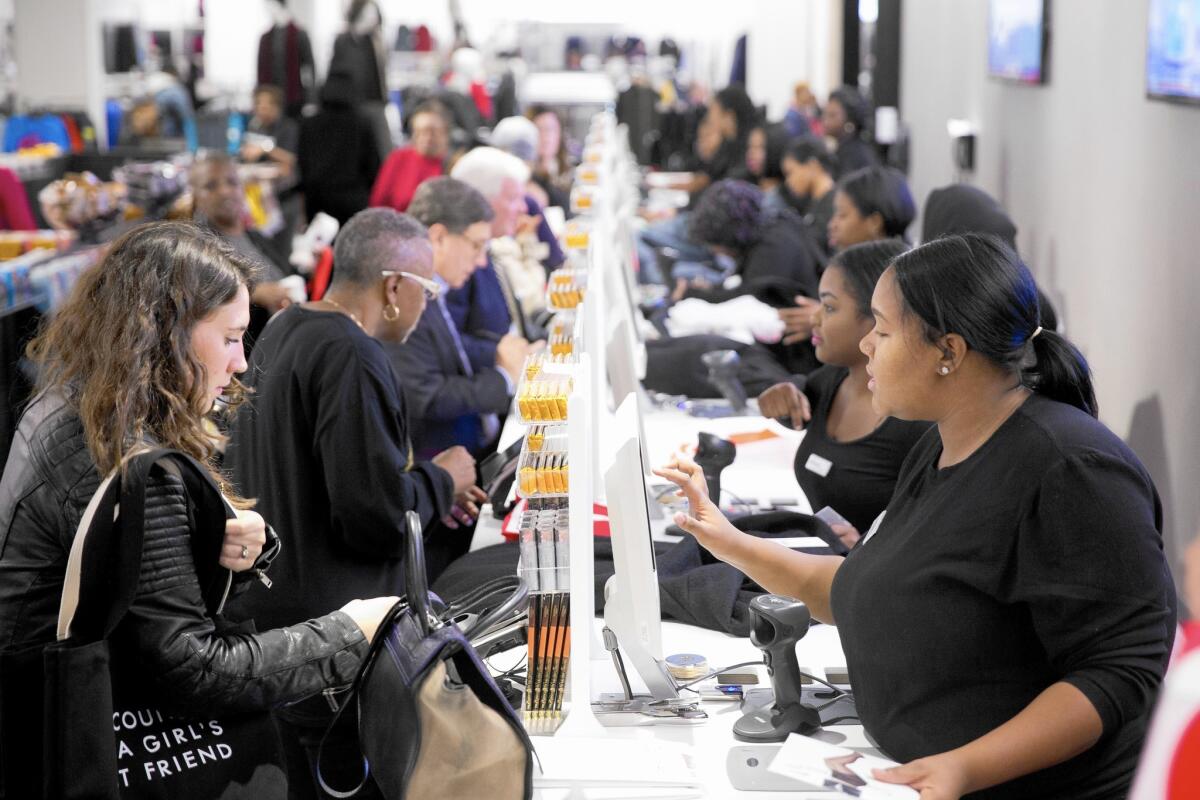Consumer spending drops in September as income growth slows

- Share via
Reporting from washington — Americans unexpectedly tightened their purse strings a bit in September, sending consumer spending to its first drop in eight months, as income growth slowed, the Commerce Department said Friday.
Consumer spending declined 0.2% after a jump of 0.5% in August. Meanwhile, personal income rose 0.2% in September, the smallest rise since December. Incomes were up 0.3% in August.
Both percentages were below analysts’ estimates that spending would slow last month but still tick up 0.1% and that incomes would rise 0.3%.
Economists downplayed the $19-billion drop in spending to $11.97 trillion, noting that it came after August’s big increase.
Consumer spending, including monthly mortgage payments that are not included in the Commerce Department figures, accounts for about two-thirds of the nation’s economic activity.
Auto purchases accounted for most of the decrease in September and most of the increase in August, the Commerce Department said.
Chris Rupkey, chief financial economist at Union Bank, said that auto sales still were strong in September and that he was optimistic overall spending would quickly bounce back.
“The future for consumer spending looks bright with falling gasoline prices putting extra dollars in consumers’ pockets. And for the first time since the recession, we can say it looks like wages are starting to rise,” he said.
Chris G. Christopher Jr., director of consumer economics at IHS Global Insight, said falling gas prices were “a big plus for discretionary spending and consumer mood” entering the holiday shopping season.
Spending probably rebounded in October and holiday retail sales are expected to be stronger this year than last year, he said.
Further boosting the bullish outlook was a private report Friday showing consumer confidence at its highest level since mid-2007.
The index from the University of Michigan and Thomson Reuters rose 2.7 points to 86.9 in October, the third-straight monthly increase, as consumers had more favorable views of their finances and the economy’s outlook.
The October figure was about normal for the index, which was started in 1978. During the Great Recession, it dropped to a low of 55.3 in November 2008.
With spending down in September and incomes still rising slightly, Americans saved more.
The savings rate rose to 5.6% in September, up from 5.4% the previous month, the Commerce Department said.
The new data came after the government reported Thursday that the overall pace of economic growth slowed in the third quarter.
Gross domestic product, a broad measure of economic activity, rose at a still-healthy 3.5% annual rate after a 4.6% increase in the second quarter.
Part of the reason for the slowdown was a drop in consumer spending. It increased at an annual rate of 1.8% in the third quarter, down from a 2.5% annual rate in the second quarter.
Inflation remained low in September, the Commerce Department said.
The personal consumption expenditure price index, the Federal Reserve’s preferred inflation gauge, rose 0.1% in September. It had dropped 0.1% the previous month.
For the 12-month period that ended Sept. 30, prices were up 1.4%, well below the Fed’s annual target of 2%.
More to Read
Inside the business of entertainment
The Wide Shot brings you news, analysis and insights on everything from streaming wars to production — and what it all means for the future.
You may occasionally receive promotional content from the Los Angeles Times.











